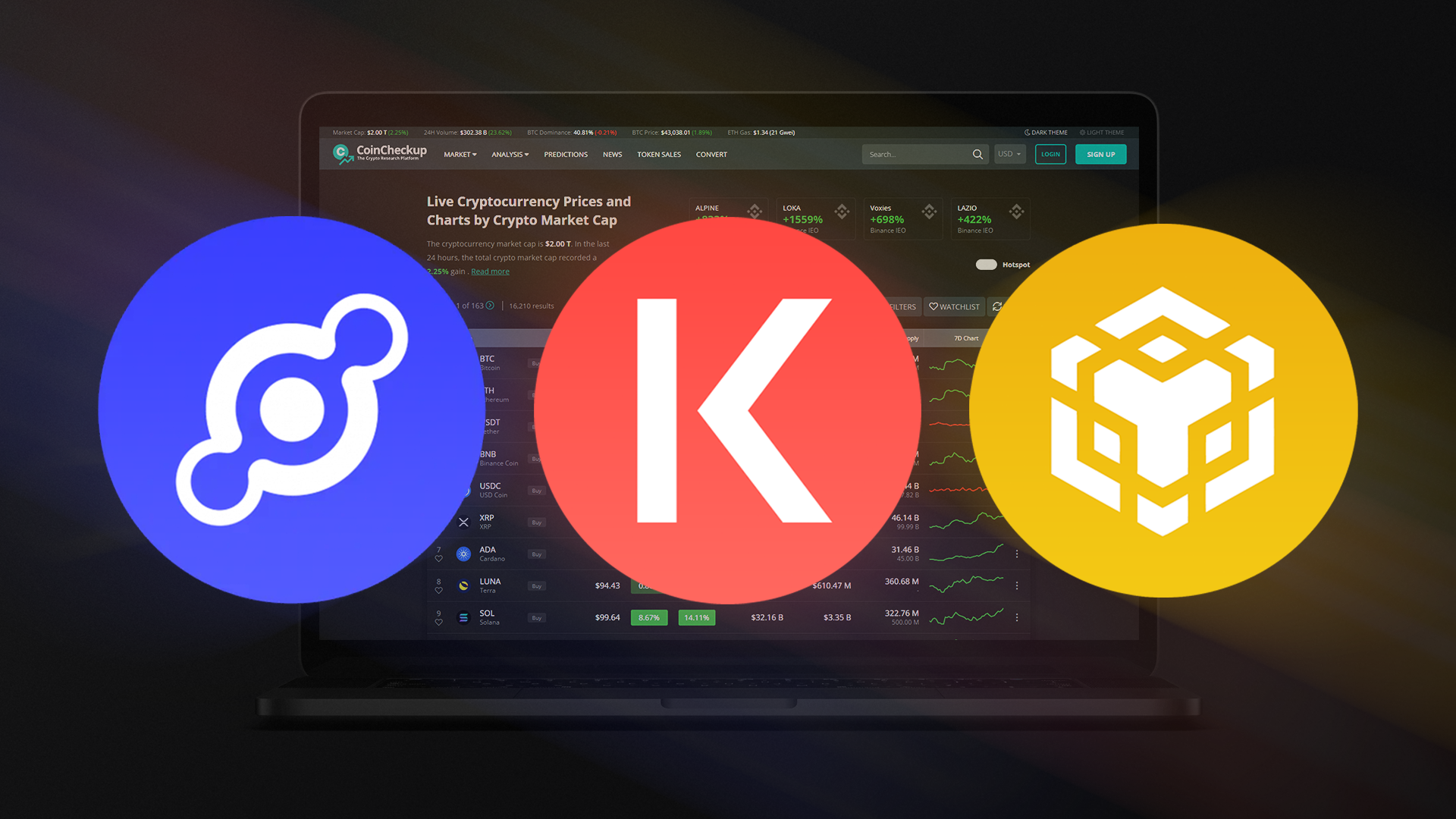
After another week of rather sideways trading the total cryptocurrency market capitalization still hoovers around $1 trillion as we enter Week 36. Perhaps, as the Ethereum Merge approaches a new trend cryptocurrency market trend will crystalize, causing the total capitalization to either lift off or take a dive even deeper, below the current $1 trillion valuation. Either way the market plays out, you are more likely to end the week in the green if you follow the news from the crypto world. So here is our Top 3 Coins to Watch article – essentially a short summary of future (and past) events that are likely going to influence the prices of associated cryptocurrencies this week.

3. Helium (HNT)
Helium is a project that aims to build a decentralized wireless internet infrastructure owned by the people and not telecom conglomerates. This is the main reason why Helium project calls itself is “the People’s Network”. Anyone who wishes to contribute to a more connected future can join the decentralized machine network by setting up a wireless network in their city and operating a Helium Hotspot, for which the operators are rewarded in HNT tokens. The People’s Network utilizes two units of exchange: HNT and Data Credits and their circulating supply is determined based on a Burn-and-Mint Equilibrium token model. The Helium blockchain also relies on a special Proof-of-Coverage (PoC) algorithm to verify that Helium hotspots are located where their operators claim they are. According to Helium’s explorer, there are currently over 942,000 Helium hotspots deployed worldwide.
Helium developers have proposed a transition to Solana blockchain to accommodate the rapid growth of the network
Helium core developers have recently made a bold move as they have proposed to ditch Helium’s native blockchain and transition the network to Solana to accommodate the rapid growth of the network. The transition to Solana is part of the Helium Improvement Proposal 70, which has been presented to the public and the Helium governance community on Tuesday, August 30. Besides moving to Solana, the HIP 70 also includes two protocol tweaks, which aim to minimize Helium’s need for on-chain processing, these are moving Proof-of Coverage and Data Transfer Accounting to Oracles.
The Helium developers believe that “improving operational efficiency and scalability” of the network is of crucial importance if they want to attract “significant economies of scale” to the network. The governance vote on HIP 70 will start on September 12 and end on September 18. The proposal to migrate to Solana comes after Helium’s native token lost almost 90% since the start of the year. However, if HIP 70 gets approved, the move to Solana blockchain could spark some positive HNT price activity. In addition, operating in a more scalable ecosystem will allow Helium to keep up with the growing number of hotspots and users in the future as well.

2. Kava (KAVA)
Kava is a high throughput Layer 1 blockchain developed by Kava Labs. It is designed to use an innovative blockchain architecture of two co-chains working side by side to create a unified scalable network and facilitate a myriad of decentralized finance (DeFi) use cases. Kava’s own Tendermint consensus engine combines Ethereum’s smart contract capabilities with Cosmos’ interoperability to facilitate transactions for thousands of supported decentralized applications. To achieve cross-chain communication and asset transfers, the Kava ecosystem utilizes IBC Protocol and ChainLink’s decentralized blockchain oracle network. Kava Labs have also established close partnerships with industry leaders such as Binance, Kraken and Ripple. The platform’s native token KAVA is used to transfer value on the network and plays a key role in the governance of the blockchain.
Kava 11 mainnet launch date revealed – the update is going live on September 8
According to a recent announcement, Kava 11 mainnet is launching on September 8, 17:00 UTC. The revamped version of the Kava protocol brings several liquidity improvements, including introducing support for Kava EVM assets in Mint and Lend products, the launch of Kava Earn Yield Optimizer and rolling-out a feature that will allow users to Sign SDK transactions for Ethereum assets in a single Metamask Wallet. But that’s not everything yet! Kava 11 will also introduce liquid staking, a feature that will allow KAVA stakers to earn them additional rewards on top of their normal staking rewards.
Kava is known for its continued development as Kava 10 got deployed only a few months back, this is in May this year. The high-paced development will apparently continue in the future as Kava users can expect two additional developmental milestones in Q3 2022. According to the project’s roadmap, the developers are soon going to launch the ETH bridge, which will allow ERC-20 assets and ETH to be seamlessly utilized on the Kava Network and vice versa. The team also plans to launch the Kava Foundation, a non-profit organisation that will serve as an advisory body to the Kava DAO and its community, this quarter. As you can see Q3 2022 is going to be packed with Kava-related events.

1. BNB (BNB)
BNB (BNB) originally launched as Binance Coin in 2017 as an ERC-20 token sold through an initial coin offering (ICO). In April 2019, the Binance Chain was launched, and all the existing ERC-20 tokens were replaced with the BNB coin, which became the native cryptocurrency of the new blockchain. Binance Chain is still completely centralized, with Binance having complete control of block management. Binance users who utilize BNB to pay for trading, withdrawal and listing fees enjoy discounts. While this used to be pretty much the only use case of BNB, the coin has a far greater utility now as it allows users to pay for gas fees, earn cashback on Binance Visa card purchases, stake BNB and participate in liquidity pools and other DeFi activities. BNB is also used to determine eligibility to participate in Initial Exchange Offerings (IEOs). In addition, the Binance ecosystem keeps expanding, which means that new products and services are regularly added.
BNB showed more resilience than the majority of crypto assets in the most recent bear market
Historical price data shows that BNB has shown significantly more resiliency to the latest bear market than most top digital assets. While Bitcoin, for example, lost almost a third of its value during the last 3 months, BNB is down by only 8% in the same time frame. Furthermore, BNB bounced by over 50% from its June yearly low. The Binance Coin’s defying price action is likely as a result of growing BNB Smart Chain activity and Binance’s stature as the largest crypto exchange. According to Arcane Research no other cryptocurrency exchange comes near Binance, which attracts more than 300 million users in a 90-day period.
In addition, Binance is still adhering to the accelerated BNB burning program, where a portion of the exchange’s profits are allocated to purchase BNB and forever remove it out of circulation. Besides quarterly BNB burns, a small portion of each BSC Chain transaction fee is also forever destroyed. Both mechanisms ensure that the amount of BNB in circulation is decreasing. In other news, BNB Beacon Chain (BEP2) Mainnet recently underwent the “Godel” Upgrade. This Binance-supported hard fork that was executed on September 2, deactivated the DEX module on the Beacon Chain as all AMM protocols have been running smoothly on the BSC. Binance noted that this will give leave Beacon Chain “more computing power for future computing and governance focuses”. Was that a hint that new features are coming to the BNB Beacon Chain?



